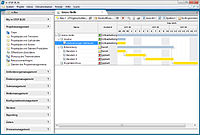In-STEP BLUE
| in-STEP BLUE
|
|
|---|---|

|
|
| Basic data
|
|
| developer | microTOOL GmbH |
| Current version | 6.5 (January 23, 2020) |
| operating system | Windows |
| category | Project management software |
| License | Proprietary |
| German speaking | Yes |
| www.microtool.de/produkte/in-step-blue/ | |
in-STEP BLUE is a project management software that is developed and sold by microTOOL GmbH based in Berlin. The software supports project managers in project planning , in resource management , in determining work progress, in cost and effort planning , in requirements management , in change management and risk management, and in establishing standards and process models. The application automatically saves all project results in a central project library. Individual project management methods can be supported by the software as well as the agile method Scrum , the British project management method PRINCE2 , the German V-Modell XT, the Swiss method Hermes and the standard Automotive SPICE (ISO / IEC 15504).
The user interface is available in German and English. There are over 60,000 registered users in around 4,000 companies worldwide.
Functions
in-STEP BLUE enables process-based IT project management and compliance with the following functions:
- Project management , project portfolio management and resource management
- The software supports project planning and task management by dividing projects into phases, iterations , milestones , work packages and activities, depending on which process is being used. The project plan is automatically updated continuously. The software offers editable product templates for project results and automatically versioned these documents. The project employees receive individual to-do lists . The progress of the project as well as the time, cost and effort planning can be evaluated and controlled at any time thanks to the integrated time recording. The groupware is accessed via LAN or the Internet. In the case of several parallel running projects within an organization, cross-project views and evaluations can be created. The resources of an organization can thus be assigned to different projects.
- Requirements management , change management , software configuration management and document management
- The requirements and change requests from all stakeholders are recorded, analyzed, prioritized and then visible as tasks in the project plan. The automatic versioning of all products in a central product library guarantees the traceability of any artifacts. All changes are visible in the revision history and can be compared with one another.
- Quality management
- Requirements can be linked to test cases. The planning and control of quality assurance measures are supported by displaying all documents relevant for an evaluation and defining automated workflows for reviews and QA cycles. Individual evaluations of tests and test cases can be created.
- Process management
- The software supports working with process standards in organizations that operate multi -project management. Processes can be customized to meet the needs of individual projects. Process standards and improvements can be derived from successful projects and the process maturity can be increased according to the Capability Maturity Model Integration CMMI.
- Integration with Microsoft and other programs
- in-STEP BLUE is fully integrated with Microsoft Office Word and Excel for uniform documentation. Interfaces to MS Visio, MS Project, MS Outlook as well as exports in HTML, XML and PDF are available.
Development history
Version 1.0 of the process and configuration management software in-Step was published in 1997. Since many companies introduced process-based project management based on the Capability Maturity Model (CMM) to improve their software technology, in-Step was developed. Especially users of the German procedural standard in public administration, V-Modell 97, found the right support in the software.
In 2002 the tool was expanded to include functions for project management, requirements management and configuration management.
Version 3.0 was released in 2004 and offered new editions for requirements-based development, for agile projects according to Extreme Programming and for projects according to PRINCE2 . When the new standard for public administration, V-Modell XT, came out in 2005, a V-Modell XT Edition was published which offered functions for adaptation, project planning and quality assurance according to V-Modell XT.
In 2008 the in-Step Scrum Edition and the in-Step SPICE Edition for automotive were added.
In 2010 the in-Step HERMES Edition for the Swiss project management method HERMES was published.
In 2014 in-Step was renamed in-STEP BLUE, because another software for project planning with requirements engineering , in-STEP RED, came onto the market.
In 2017, the project management software was supplemented by a web app that can be used to create and edit project applications, requirements, test cases, change requests, risks and tickets.
credentials
- VMEA 2014: Lecture by Thomas Kästle, Tesat-Spacecom GmbH & Co. KG . Lecture as PDF
- Dr. Veikko Krypczyk: It depends on the model: Requirements analysis depending on the process model. In: VisualStudioOne, issue 03/2013, pp. 45–49.
- PMO Day 2012: Lecture by Astrid Kuhlmey, Project Management Office Service & Technologie, Bayer Business Services GmbH . Program flyer
- REConf 2009: Lecture by Mirko Pracht, Command Marine Command Systems . Lecture as PDF
- Martina Hafner: project management software. Make scheduling dependencies in the project more visible . www.elektronikpraxis.vogel.de. April 14, 2009.
- Hendrik Härter: project management tool. Component for requirements management with UML and BPMN . www.elektronikpraxis.vogel.de. October 26, 2007.
- Stefan Ueberhorst: Microtool makes project management more flexible . www.computerwoche.de. March 27, 2007.
- Mey Mark Meyer: PM software: in-Step. IT project management with process models . In: GPM magazine PMaktuell. 2/2006, pp. 50-52.
- Stefan Ueberhorst: in-Step makes working with the V-model easier . www.computerwoche.de. August 6, 2004.
- User presentations on YouTube [1]